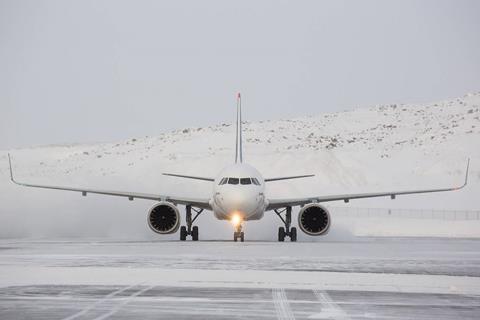Airbus’s specialist flight-operations division, Navblue, has unveiled a new runway contamination reporting system which uses the aircraft as a condition sensor during landing roll-out.
Over 10 carriers have signed up for the system, designated RunwaySense, covering a total of more than 880 aircraft.
Airbus had signalled to FlightGlobal more than two years ago that it was preparing to deploy a system, through Navblue, which would gather performance data from aircraft to relay accurate, almost real-time data about runway condition.
The new system is based on braking action computation function software, released by Navblue on Airbus A320-family jets last year.
As the aircraft lands the software generates a message about the condition of the runway surface, compared with the US FAA’s runway condition assessment matrix for take-off and landing performance.
The data will become accessible for integration with users’ tools through dedicated Navblue channels.

Navblue vice-president of programmes Thomas Lagaillarde says the system’s use of aircraft performance information to assess runway conditions makes it “truly unique”.
“By transforming the aircraft into a sensor we’re maximising the airports’ knowledge of their runway performance and therefore increasing safety for aircraft and airports,” he adds, pointing out that the available data will increase as the customer base expands.
“We believe the community model of sharing data is the right direction of travel for all aviation stakeholders.”
Navblue says the data can be used to improve the timing of airport runway-sweeping operations or increase de-icing efficiency, while airlines can enhance monitoring of their operations through their own or other carriers’ information.
Introduction of RunwaySense comes ahead of the deadline for ICAO global reporting format for runway conditions, which had been set for 5 November this year but – owing to the coronavirus crisis – has been pushed back to 4 November 2021.
The development follows concerns over the accuracy of conventional braking condition information.
Investigators of landing incidents have previously identified a need for aircraft-based surface measurement and communication. Recommendations to examine the feasibility of such a system were made after the fatal overrun of a Southwest Airlines Boeing 737-700 at Chicago Midway in late 2005.
Shortfalls in the accuracy and timeliness of runway condition information were also highlighted by the European Union Aviation Safety Agency in a January 2018 safety bulletin.
ICAO has spent more than a decade exploring the complex nature of runway surface friction and developing a harmonised methodology for assessment, in order to produce a standardised and simple reporting format to improve safety and situational awareness.


























